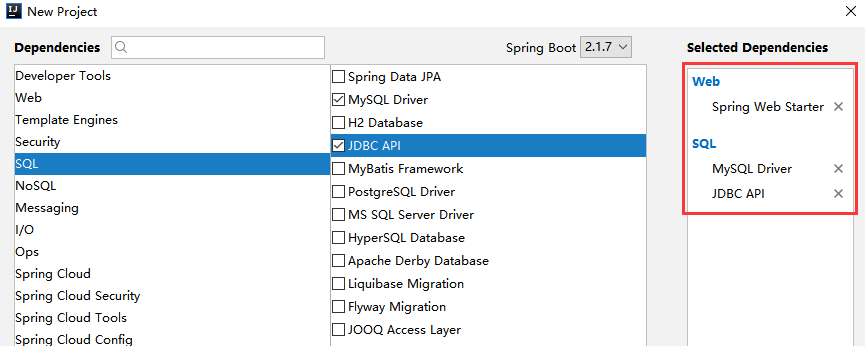SpringBoot中的数据访问(JDBC、Druid、Mybatis整合)
对于数据访问层,无论是 SQL 还是 NOSQL,Spring Boot 底层都是采用 Spring Data 的方式进行统一处理各种数据库,
Spring Data 也是 Spring 中与 Spring Boot、Spring Cloud 等齐名的知名项目。
JDBC
创建项目时引入JDBC模块

默认自动导入了以下依赖
<dependency> <groupId>org.springframework.boot</groupId> <artifactId>spring-boot-starter-jdbc</artifactId> </dependency> <dependency> <groupId>mysql</groupId> <artifactId>mysql-connector-java</artifactId> <scope>runtime</scope> </dependency>
IDEA连接上数据库后,在yaml中加入数据源配置即可
spring: datasource: username: root password: 123456 url: jdbc:mysql://localhost:3306/mybatis?serverTimezone=UTC&useUnicode=true&characterEncoding=utf-8 driver-class-name: com.mysql.jdbc.Driver
springboot2.0以上版本默认使用 com.zaxxer.hikari.HikariDataSource 数据源,
Spring本身也对原生的JDBC 做了轻量级的封装,即 org.springframework.jdbc.core.JdbcTemplate
JdbcTemplate 的自动配置原理是依赖 org.springframework.boot.autoconfigure.jdbc 包下的
org.springframework.boot.autoconfigure.jdbc.JdbcTemplateAutoConfiguration 类
测试使用
@RestController public class JdbcController { //JdbcTemplate 是 core 包的核心类,用于简化 JDBC操作,还能避免一些常见的错误,如忘记关闭数据库连接 //Spring Boot 默认提供了数据源,默认提供了 org.springframework.jdbc.core.JdbcTemplate //JdbcTemplate 中会自己注入数据源,使用起来也不用再自己来关闭数据库连接 @Autowired JdbcTemplate jdbcTemplate; //查询student表中所有数据 //List 中的1个 Map 对应数据库的 1行数据 //Map 中的 key 对应数据库的字段名,value 对应数据库的字段值 @GetMapping("/userList") public List<Map<String, Object>> userList(){ String sql = "select * from user"; List<Map<String, Object>> maps = jdbcTemplate.queryForList(sql); return maps; } }
Druid
Druid 是阿里巴巴开源平台上一个数据库连接池实现,结合了 C3P0、DBCP、PROXOOL 等 DB 池的优点,同时加入了日志监控。
Druid 可以很好的监控 DB 池连接和 SQL 的执行情况,天生就是针对监控而生的 DB 连接池。
确认导入如下依赖
<dependency> <groupId>com.alibaba</groupId> <artifactId>druid</artifactId> <version>1.1.12</version> </dependency> <dependency> <groupId>org.springframework.boot</groupId> <artifactId>spring-boot-starter-jdbc</artifactId> </dependency> <dependency> <groupId>mysql</groupId> <artifactId>mysql-connector-java</artifactId> <scope>runtime</scope> </dependency> <dependency> <groupId>log4j</groupId> <artifactId>log4j</artifactId> <version>1.2.17</version> </dependency>
编辑yml配置文件,修改数据源相关配置
spring: datasource: username: root password: 123456 url: jdbc:mysql://localhost:3306/mybatis?serverTimezone=UTC&useUnicode=true&characterEncoding=utf-8 driver-class-name: com.mysql.cj.jdbc.Driver type: com.alibaba.druid.pool.DruidDataSource #Spring Boot 默认是不注入这些属性值的,需要自己绑定 #druid 数据源专有配置 initialSize: 5 minIdle: 5 maxActive: 20 maxWait: 60000 timeBetweenEvictionRunsMillis: 60000 minEvictableIdleTimeMillis: 300000 validationQuery: SELECT 1 FROM DUAL testWhileIdle: true testOnBorrow: false testOnReturn: false poolPreparedStatements: true #配置监控统计拦截的filters,stat:监控统计、log4j:日志记录、wall:防御sql注入 #如果允许时报错 java.lang.ClassNotFoundException: org.apache.log4j.Priority #则导入 log4j 依赖即可,Maven 地址: https://mvnrepository.com/artifact/log4j/log4j filters: stat,wall maxPoolPreparedStatementPerConnectionSize: 20 useGlobalDataSourceStat: true connectionProperties: druid.stat.mergeSql=true;druid.stat.slowSqlMillis=500
新建配置类,应用数据源配置文件,注入容器,
配置Druid监控,Druid提供了一个 web 界面方便用户查看,类似路由器配置页面
所以第一步需要设置 Druid 的后台管理页面,比如 登录账号、密码 等;配置后台管理;
@Configuration public class DruidConfig { /* 将自定义的 Druid数据源添加到容器中,不再让 Spring Boot 自动创建 绑定全局配置文件中的 druid 数据源属性到 com.alibaba.druid.pool.DruidDataSource从而让它们生效 @ConfigurationProperties(prefix = "spring.datasource"):作用就是将 全局配置文件中 前缀为 spring.datasource的属性值注入到 com.alibaba.druid.pool.DruidDataSource 的同名参数中 */ @ConfigurationProperties(prefix = "spring.datasource") @Bean public DataSource druidDataSource() { return new DruidDataSource(); } //配置 Druid 监控管理后台的Servlet; //内置 Servlet 容器时没有web.xml文件,所以使用 Spring Boot 的注册 Servlet 方式 @Bean public ServletRegistrationBean statViewServlet() { ServletRegistrationBean bean = new ServletRegistrationBean(new StatViewServlet(), "/druid/*"); Map<String, String> initParams = new HashMap<>(); initParams.put("loginUsername", "admin"); //后台管理界面的登录账号 initParams.put("loginPassword", "123456"); //后台管理界面的登录密码 //后台允许谁可以访问 //initParams.put("allow", "localhost"):表示只有本机可以访问 //initParams.put("allow", ""):为空或者为null时,表示允许所有访问 initParams.put("allow", ""); //deny:Druid 后台拒绝谁访问 //initParams.put("alan", "192.168.1.20");表示禁止此ip访问 //设置初始化参数 bean.setInitParameters(initParams); return bean; //这些参数可以在 com.alibaba.druid.support.http.StatViewServlet 的父类 com.alibaba.druid.support.http.ResourceServlet 中找到 } }
配置web监控的filter
这个过滤器的作用就是统计 web 应用请求中所有的数据库信息,比如 发出的 sql 语句,
sql 执行的时间、请求次数、请求的 url 地址、以及session 监控、数据库表的访问次数 等等
//配置 Druid 监控 之 web 监控的 filter //WebStatFilter:用于配置Web和Druid数据源之间的管理关联监控统计 @Bean public FilterRegistrationBean webStatFilter() { FilterRegistrationBean bean = new FilterRegistrationBean(); bean.setFilter(new WebStatFilter()); //exclusions:设置哪些请求进行过滤排除掉,从而不进行统计 Map<String, String> initParams = new HashMap<>(); initParams.put("exclusions", "*.js,*.css,/druid/*"); bean.setInitParameters(initParams); //"/*" 表示过滤所有请求 bean.setUrlPatterns(Arrays.asList("/*")); return bean; }
整合mybatis
导入mybatis依赖
<dependency> <groupId>org.mybatis.spring.boot</groupId> <artifactId>mybatis-spring-boot-starter</artifactId> <version>2.1.0</version> </dependency>
创建pojo类
public class User { private int id; private String name; private String pwd; //get set 有参无参构造方法 tostring }
创建dao类
@Mapper //mybatis注册 或在启动类中配置mapperscan @Repository //注入容器 public interface UserDao { //选择全部用户 List<User> selectUser(); }
创建controller类
@RestController public class UserController { @Autowired private UserDao userDao; //选择全部用户 @GetMapping("/selectUser") public List<User> selectUser(){ List<User> users = userDao.selectUser(); return users; } }
创建mapping配置文件
<?xml version="1.0" encoding="UTF-8" ?> <!DOCTYPE mapper PUBLIC "-//mybatis.org//DTD Mapper 3.0//EN" "http://mybatis.org/dtd/mybatis-3-mapper.dtd"> <mapper namespace="com.alan.mybatis.dao.UserDao"> <select id="selectUser" resultType="User"> select * from user </select> </mapper>
编写application.properties,配置数据源、mapping配置文件映射、mapping配置文件中pojo类
spring.datasource.username=root spring.datasource.password=123456 spring.datasource.url=jdbc:mysql://localhost:3306/mybatis?serverTimezone=UTC&useUnicode=true&characterEncoding=utf-8 spring.datasource.driver-class-name=com.mysql.cj.jdbc.Driver #resources目录下 mybatis.mapper-locations=classpath:mybatis/mapping/*.xml mybatis.type-aliases-package=com.alan.mybatis.pojo
测试数据源
@SpringBootTest class SpringbootMybatisApplicationTests { @Autowired DataSource dataSource; @Test void contextLoads() throws SQLException { System.out.println("数据源>>>>>>" + dataSource.getClass()); Connection connection = dataSource.getConnection(); System.out.println("连接>>>>>>>>>" + connection); System.out.println("连接地址>>>>>" + connection.getMetaData().getURL()); connection.close(); } }
启动应用测试





 浙公网安备 33010602011771号
浙公网安备 33010602011771号